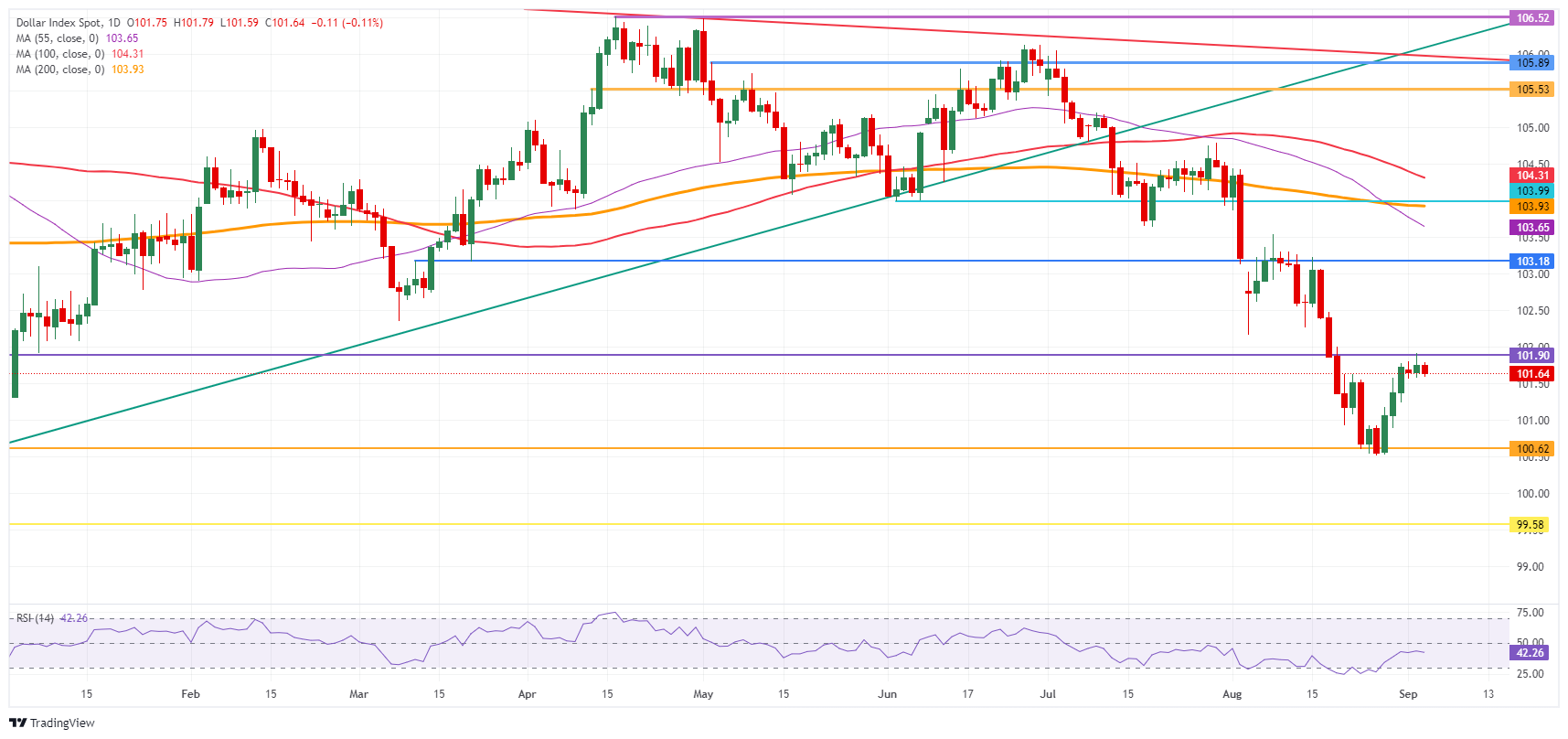- The US dollar is trading within a tight range this week ahead of key US employment data.
- Markets brace for JOLTS numbers after ISM Manufacturing PMI failed to move the needle.
- The US Dollar Index remains just below an important technical level.
The US Dollar (USD) is trading sideways on Wednesday, awaiting some key US economic data. Meanwhile, equity markets are suffering from a severe hangover with selling off of tech stocks. The nosedive came after NVIDIA (NVDA) received a subpoena from the US Department of Justice over whether the chipmaker violated antitrust laws.
In terms of economic data, all eyes will be on the appetizer that precedes the US employment reports with the release of Non-Farm Payrolls (NFP) on Friday, and the release of JOLTS job openings on Wednesday. Although there is no correlation between the two figures, the JOLTS job openings report can reveal whether certain sectors are reducing their demand for labor. Markets have not yet decided whether the US Federal Reserve (Fed) will cut 25 or 50 basis points in September.
Daily Summary What’s Moving the Market Today: This week, the focus is on employment data
- During Tuesday’s trading session in the US, news broke that the US Department of Justice had subpoenaed NVIDIA (NVDA) for possible violations of antitrust laws. This triggered a wave of selling in the technology sector that extended into the Asian and European session.
- At 11:00 GMT, the Mortgage Bankers Association will publish its Mortgage Applications Index for the last week of August. The previous figure was a meager 0.5%.
- At 12:30 GMT, data on the Gods and the US trade balance will be released. For July, a deficit of $79 billion is expected after a June deficit of $73.1 billion.
- At 14:00 GMT, the JOLTS job openings report for July will be released. The figure for June was 8.184 million vacancies, with 8.1 million expected for July. At the same time, Factory Orders data is expected to emerge from the 3.3% contraction in June and come in at a positive 4.7% in July.
- Stocks are selling off in the wake of the Nvidia quote. In Japan, both the Nikkei and Topix indexes are down nearly 4%. European stocks are opening down more than 1%.
- CME’s Fedwatch tool shows a 59.0% chance of the Fed cutting interest rates by 25 basis points (bps) in September, versus a 41.0% chance of a 50 bps cut. Another 25 bps cut in November (if a 25 bps cut occurs in September) is expected at 40.0%, while there is a 46.8% chance of rates being 75 bps (25 bps + 50 bps) below current levels and a 13.2% chance of rates being 100 (25 bps + 75 bps) basis points lower.
- The US 10-year benchmark rate is trading at 3.81%, the lowest level this week.
US Dollar Index Technical Analysis: JOLTS can do the trick
The US Dollar Index (DXY) appears to be stuck in a tight range, holding there for now after Tuesday’s data failed to move the needle. With Wednesday’s JOLTS job openings report, the assumption is the same: any figure that is substantially above or below consensus will move the DXY in either direction. Meanwhile, markets are pricing in a 50 basis point rate cut by the Fed this month, although the data does not support that stance.
Looking up, the first resistance at 101.90 could be easily broken if the JOLTS report is stronger than expected. Further up, a strong 2% rise would be needed for the index to reach 103.18. Finally, a strong resistance level near 104.00 not only has fundamental technical value but also relies on the 200-day simple moving average (SMA) as a second heavyweight to limit price action.
On the downside, 100.62 (the low of December 28) serves as support, although it looks quite weak. If broken, the low of July 14, 2023, at 99.58, will be the last level to watch. Once that level is broken, the first levels of 2023 will be near 97.73.
US Dollar Index: Daily Chart
US Dollar FAQs
The United States Dollar (USD) is the official currency of the United States of America, and the de facto currency of a significant number of other countries where it is in circulation alongside local banknotes. As of 2022, it is the most traded currency in the world, accounting for over 88% of all global foreign exchange transactions, equivalent to an average of $6.6 trillion in daily transactions. Following World War II, the USD took over from the British Pound as the world’s reserve currency.
The single most important factor influencing the value of the US dollar is monetary policy, which is determined by the Federal Reserve (Fed). The Fed has two mandates: to achieve price stability (control inflation) and to promote full employment. Its main tool for achieving these two goals is to adjust interest rates. When prices rise too quickly and inflation exceeds the Fed’s 2% target, the Fed raises rates, which helps the dollar. When inflation falls below 2% or the unemployment rate is too high, the Fed can lower interest rates, which weighs on the dollar.
In extreme situations, the Federal Reserve can also print more dollars and enact quantitative easing (QE). QE is the process by which the Fed substantially increases the flow of credit in a jammed financial system. It is an unconventional policy measure used when credit has dried up because banks are not lending to each other (for fear of counterparty default). It is a last resort when simply lowering interest rates is unlikely to achieve the necessary result. It was the Fed’s weapon of choice to combat the credit crunch that occurred during the Great Financial Crisis of 2008. It involves the Fed printing more dollars and using them to buy US government bonds, primarily from financial institutions. QE typically leads to a weakening of the US dollar.
Quantitative tightening (QT) is the reverse process whereby the Federal Reserve stops buying bonds from financial institutions and does not reinvest the principal of maturing securities in new purchases. It is generally positive for the US dollar.
Source: Fx Street
I am Joshua Winder, a senior-level journalist and editor at World Stock Market. I specialize in covering news related to the stock market and economic trends. With more than 8 years of experience in this field, I have become an expert in financial reporting.







